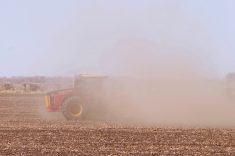In February, Farm Credit Canada’s VP and chief ag economist J.P. Gervais spoke on a webinar about the state of the farm economy.
It was hard to find a bright spot.
While there are a lot of unknowns around factors like international trade agreements (“We have more questions than answers at this time,” he said), Gervias said he thinks it’s unrealistic to expect Canadian farm cash receipts to keep growing like they have over the past decade.
As we move into a period of lower cash receipts and higher interest rates, Gervais said farmers’ first line of defence will be our working capital — that is, the cash we have available to use when we need it (the technical definition is current assets less current liabilities). Our second line of defence, he said, will be how solid our balance sheets are.
Read Also

Health hazards are often overlooked risks on the farm
While quite different from the dangers posed by farm machinery, hazards such as loud noise or sun exposure require the same proactive attention, the Canadian Agricultural Safety Association says.
Is he expecting crop price increases? Not really. Any upside, he said, is “going to be limited if it comes at all in 2018, unless there’s a disruption, weatherwise.”
None of this is the sort of cheerful, happy news I’d like to hear from an ag economist as we prepare to shell out cash for farm inputs to grow another crop.
Gervais said we’re going to need a shift in paradigm. With a low likelihood of higher commodity prices, growing our farm incomes will come from increasing volume, not increased prices. This reminded me of that business joke about the factory that was losing $5 for every gadget it sold. “Don’t worry,” the boss said. “We’ll make it up in volume.” That sort of plan isn’t what Gervais was advising for our farms, but his talk left me a little uneasy anyway.
Meanwhile in Manitoba
Manitoba’s farm commodity groups held their Annual General Meetings at CropConnect in Winnipeg. After complaining about dull winter meetings in my last column, I have to hand it to the Manitoba Oat Growers Association, that brought in a dynamic guest speaker, Colleen Dyck, to talk about how she set up her own business making GORP Clean Energy Bars with oats as an ingredient.
Amalgamation was on the agenda at the sunflower, flax, pulse and soybeans, wheat and barley and corn grower meetings. Representatives from these five organizations are making plans to amalgamate into one big organization with a 15-person board of directors, a professional staff and regional agronomy teams that can cover all of the involved commodities.
Most of the comments from the floor were positive. Having a wide range of crops included would allow the organization to work on research in areas that don’t relate to one particular crop, like soil health, herbicide-tolerant weeds and crop rotations. There would be less administration, less risk of relying on just one or two staff members and more opportunity for staff growth. A bigger group may have a louder voice.
A farmer member of the National Sunflower Association raised the concern that smaller crops may fall through the cracks of a larger group. There may be a time when there are no sunflower growers on the amalgamated board of directors. Of course, this is already the case with small-acre pulse crops represented by the Manitoba Pulse & Soybean Growers Association, and things seem to be working well there. And, as was mentioned at the Wheat and Barley Growers Association meeting, they could always form subcommittees within the new organization.
Other farmers wondered if one big organization might see more requests for levy refunds — farmers who have never bothered requesting refunds from five different organizations may decide it’s worth their while to bother asking for a bigger refund from just one group. However, the percentage of farmers asking for levy refunds has generally been consistent over time.
While farmers turned out for the Manitoba AGMs, there wasn’t a long lineup of people looking to get elected to the boards. In fact, all of the members newly appointed to Manitoba commodity group boards in 2018 were acclaimed — there weren’t enough interested volunteers to need elections. That’s one problem that amalgamation could solve.
The next step for these five organizations will be regional meetings in the fall where members can review a detailed amalgamation plan. In early 2019, each of these five groups will hold a vote about amalgamation at their AGMs. If you farm in Manitoba, I hope you’ll take time to go and make your opinion heard.














